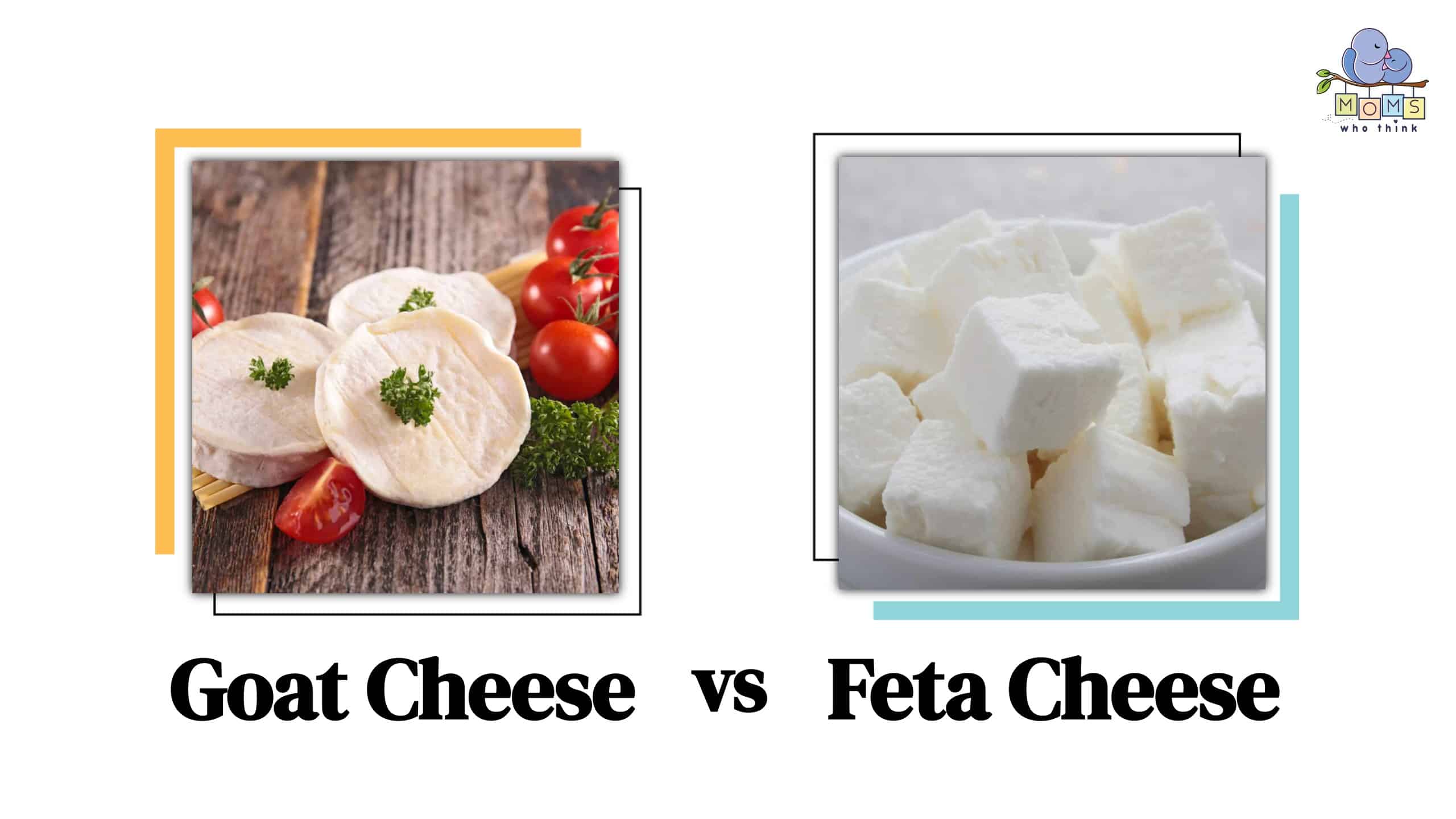At first look, goat cheese and feta cheese appear to be the same. It can be difficult to tell the difference between these two creamy and white cheeses.
While both goat and feta cheese are tangy and versatile, they have distinct characteristics that make them unique. Choosing the right cheese can make or break a dish, so let's explore the differences between these two cheeses and how to use them in your favorite recipes. Whether you're a seasoned cheese connoisseur or a curious newbie, this post is for you.
Goat Cheese vs. Feta Cheese: What Is the Difference?
While both goat cheese and feta have creamy textures, the primary difference is their milk sources. Goat cheese comes from goats while feta cheese primarily is made from sheep's milk. This leads to goat cheese having a tangy and slightly sweet flavor, which is different than feta's saltier taste. Both kinds of cheese are extremely popular and are used in everything from salads, to appetizers, to pasta.
A Comparison of Goat Cheese and Feta Cheese Nutrition
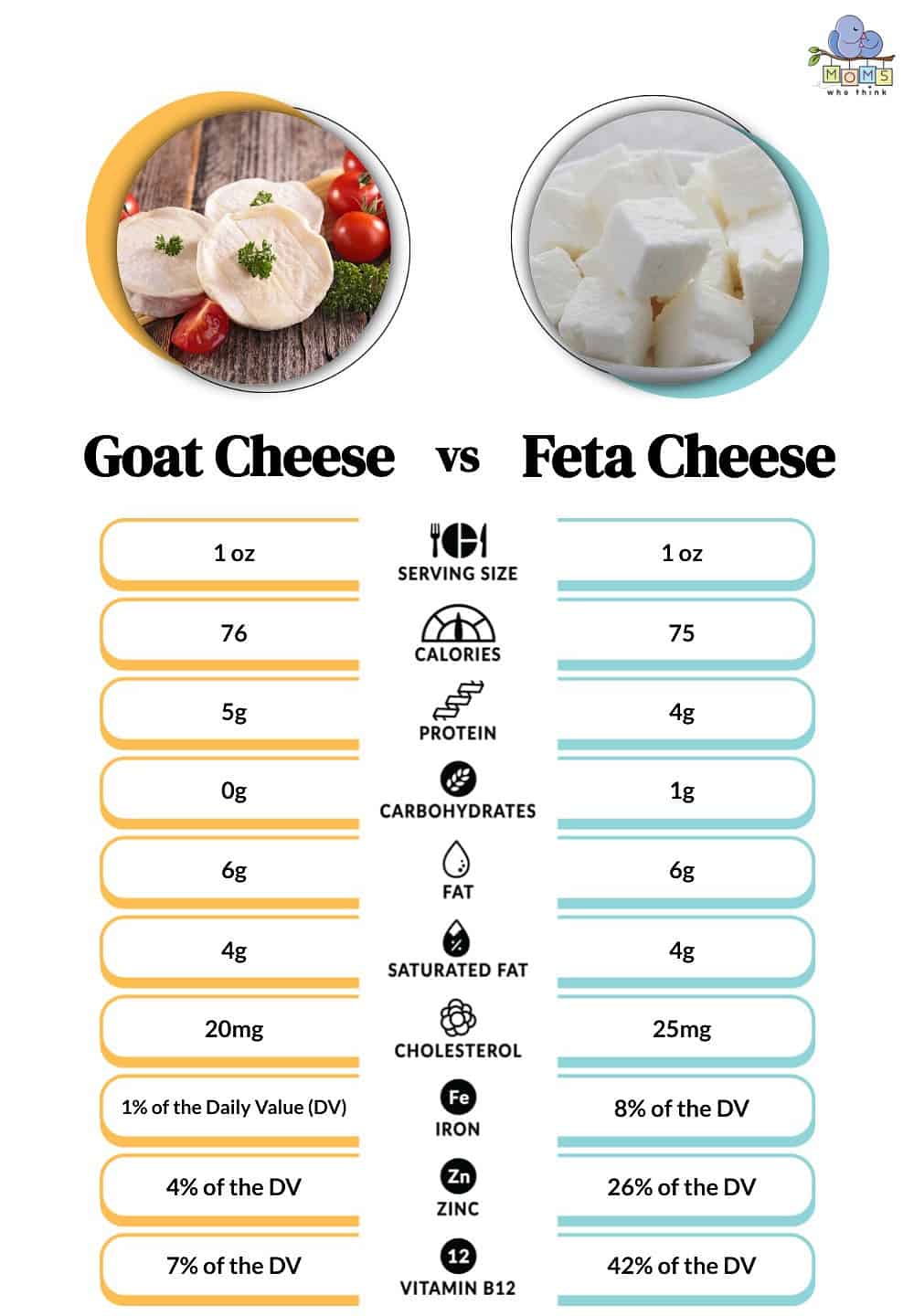
A comparison of goat cheese and feta cheese nutrition
©
Feta and goat cheese have relatively similar nutrition. Their calories per ounce can be anywhere from 70 to 100 calories depending on the brand of cheese, with goat cheese sometimes having slightly more calories per serving. Both cheeses are low in carbohydrates and get their calories from a mixture of fat and proteins.
What is Goat Cheese?
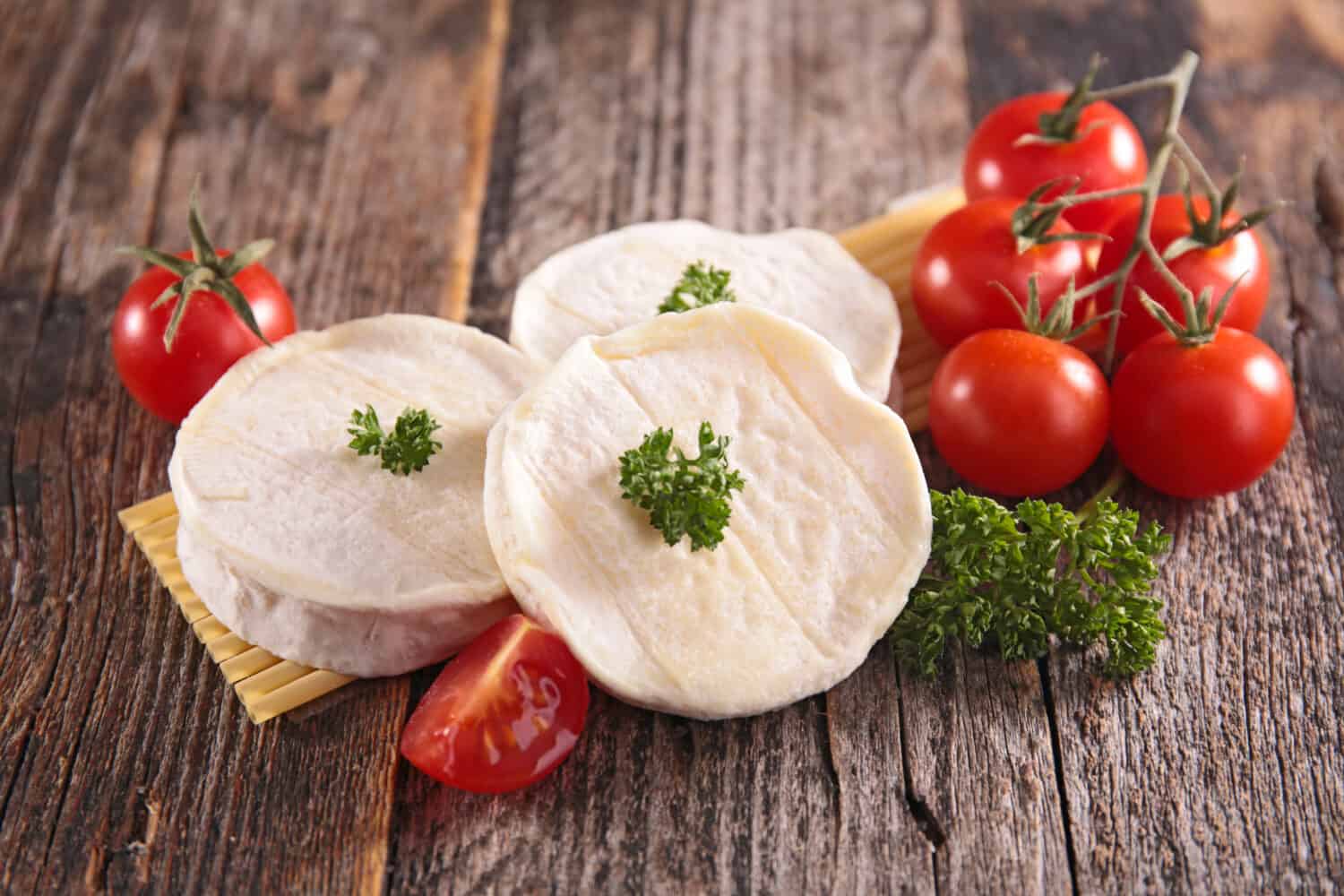
Goat cheese is soft and often sold as a round or log.
©Chatham172/Shutterstock.com
Goat cheese is a type of cheese that is made from goat's milk. It's typically a soft, spreadable cheese, but can also be more firm and crumbly depending on how long it's been aged. You can eat goat cheese on its own or use it as an ingredient in various dishes.
Origin
The exact origins of goat cheese are unknown as goats have been domesticated for thousands of years. Additionally, goat milk has been used to make cheese in various parts of the world for centuries.
It's believed, however, that goat cheese was first made in the Mediterranean region, particularly in Greece and the Middle East, where it's common to keep goats for milk. In these regions, goat cheese has been a staple food for centuries and is used in a wide range of dishes, from salads to main courses.
Characteristics and Texture
Goat cheese is typically known for its creamy and smooth texture. However, when it's allowed to age, it can become firm and crumbly. The texture depends on how the cheese is produced and how long it's aged.
Flavor
Goat cheese has a creamy, tangy flavor with a slightly sweet undertone. There are also numerous different kinds of goat cheese made all over the world. What kind of goat cheese you purchase will affect the overall flavor.
Production
The process of making goat cheese typically involves heating the goat's milk and adding a bacterial culture and rennet, which helps to curdle the milk and form curds. The curds are then drained and shaped into various forms. Most types of goat cheese are shaped into logs or rounds. As mentioned, they may also be aged for different periods of time to achieve different flavors and textures.
Popular Uses
Goat cheese can be used in a variety of recipes, including salads, pasta dishes, and appetizers. It also pairs well with ingredients such as nuts, fruits, and herbs. Because it can be eaten plain, pasteurized goat cheese makes a great addition to your next charcuterie board, too.
Heath Benefits
Goat cheese can be a healthy addition to your diet if eaten in moderation. Not only is it high in protein and heart-healthy fats, but it also contains important nutrients like riboflavin (also known as Vitamin B12). There are numerous other health benefits of goat cheese that can make it a great substitute for cow's milk in many recipes.
What is Feta Cheese?
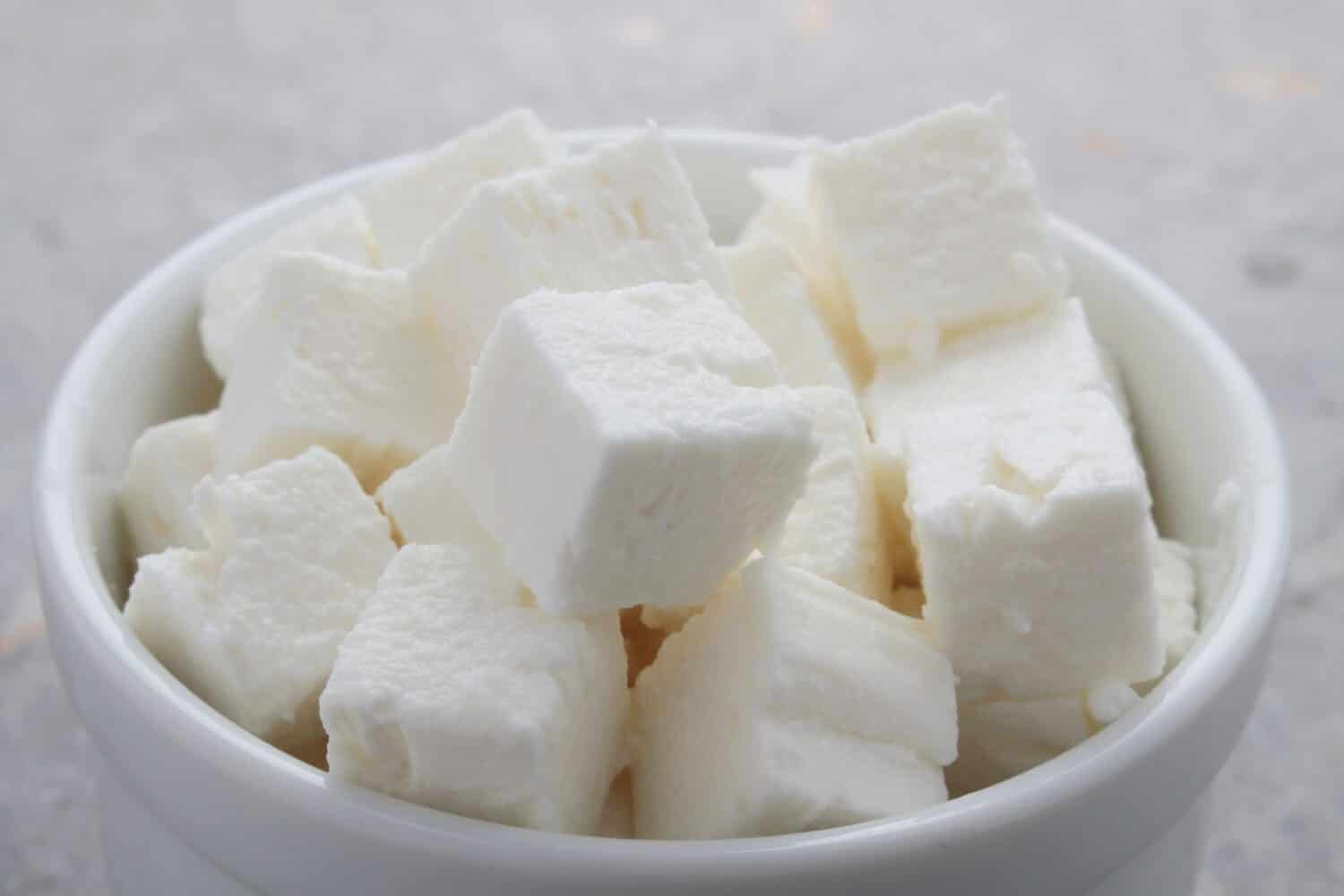
Feta cheese can be firmer and is often sold in chunks or squares.
©Chatham172/Shutterstock.com
Feta cheese is a cheese that is primarily made from sheep's milk. It can also be made with a small portion of goat's milk, which is why the two cheeses often seem similar. It's placed in a brine solution which gives it its signature salty flavor, making it different from regular goat cheese.
Origin
True feta cheese originates from Greece, making it a popular cheese for Mediterranean-style dishes. However, this cheese is now manufactured all over the world, meaning it can range in texture and flavor depending on where it was produced.
Characteristics and Texture
Feta cheese is typically firm, white, and crumbly. Greek feta cheese can be difficult to spread and may have a grainy texture to it.
Other types of feta cheese can vary in texture. For instance, French feta tends to be mild and creamier, while Bulgarian feta can be slightly less salty. What kind of feta cheese you purchase and use will depend on where it's produced.
Flavor
Feta typically has a tangy, sharp, and salty flavor. The saltiness comes from the brine solution that ages it. The level of saltiness will depend again on where and how the cheesemaker makes it.
Production
Similar to goat cheese, the process of making feta cheese involves curdling the milk with rennet. Then the curds are allowed to drain in cheesecloth for several hours. The cheese is often cut into blocks or cubes which is often how it's sold after it's aged. Once the cheese is cut, it's placed in a brine solution made from water and salt. This solution helps to preserve the cheese and gives it its characteristic flavor and texture.
Popular Uses
Feta cheese is a versatile cheese that is great in many different types of dishes. It can be found in everything from salads and sandwiches to pasta and pies. It pairs well with a variety of ingredients, such as olives, tomatoes, and cucumbers, and is often used in Mediterranean-style cuisine.
Health Benefits
While feta cheese still offers health benefits like calcium and protein, it's important to note that it's higher in saturated fat and sodium than goat cheese and should be eaten in moderation.
Can You Substitute Goat Cheese for Feta and Vice Versa?
In short, yes, these cheeses can substitute for each other in many recipes. Keep in mind, however, that altering the cheese used in your recipe may cause some differences in texture and flavor. Goat cheese offers a creamier and smoother texture with a slightly sweet and tangy flavor. Feta cheese is crumbly, salty, and sharp.
If you are substituting goat cheese for feta cheese in a recipe, you may need to adjust the amount of cheese you use because goat cheese is often milder in flavor than feta cheese. Additionally, you may need to add a bit of salt to the recipe to compensate for the lower salt content in goat cheese compared to feta cheese.
Overall, while goat cheese and feta cheese can substitute for each other in many recipes, it's important to keep in mind the differences in texture and flavor, and to adjust the recipe accordingly to achieve your desired results.
Are There Other Available Substitutes for Goat and Feta Cheese?
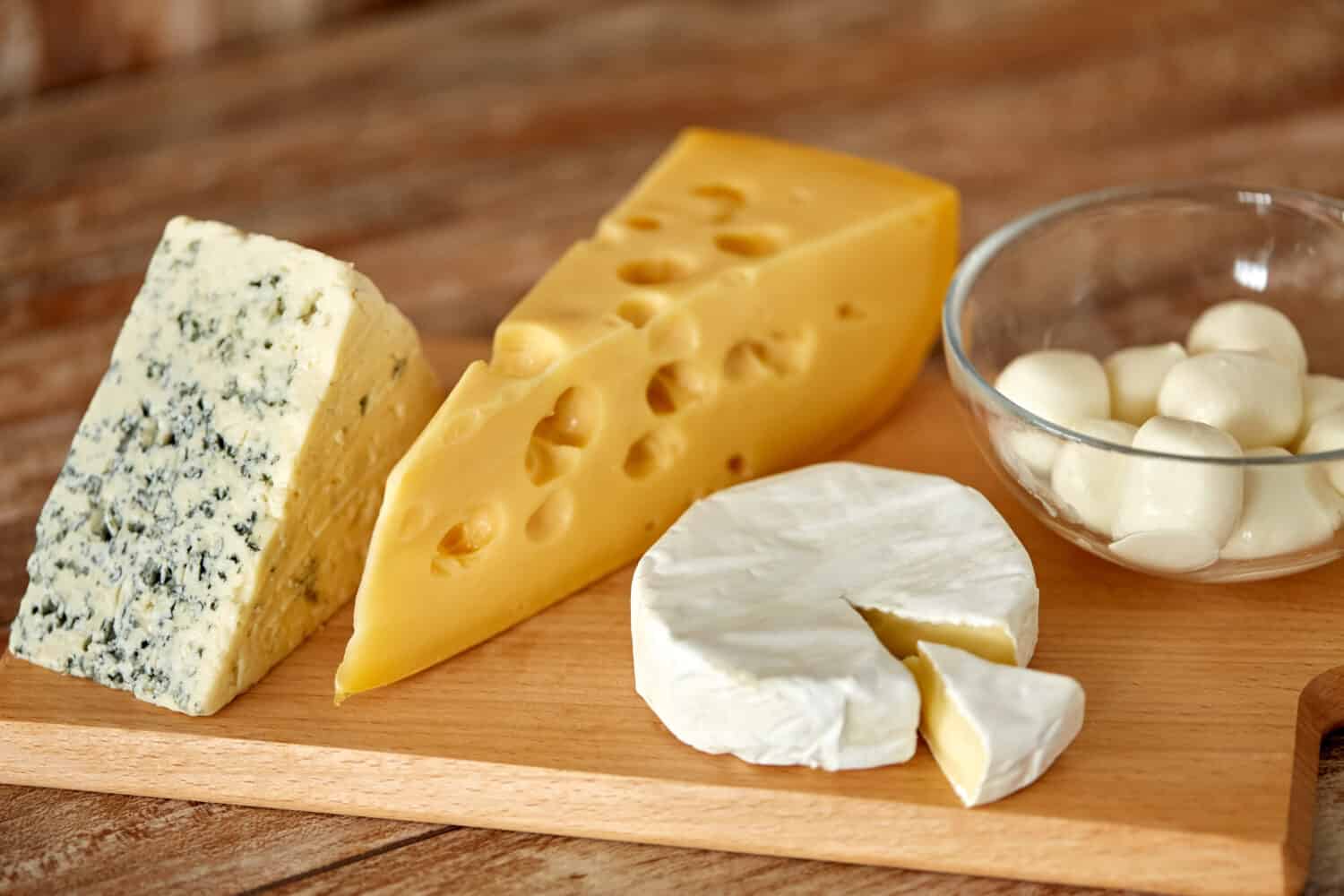
Feta and goat cheese can be substituted for other kinds of cheese.
©Ground Picture/Shutterstock.com
If you are unable to use goat cheese or feta cheese in a recipe or are looking for alternative options, here are some cheese substitutes that you can consider:
Ricotta Salata
This is a salty and crumbly cheese that you can use in place of feta cheese. It has a similar texture and flavor, but a milder taste.
Halloumi
This is a cheese that cooks often use in Mediterranean cuisine, just like feta. It has a high melting point, making it ideal for grilling or frying, and has a slightly salty and tangy flavor making it a good substitute for feta cheese.
Queso Fresco
This is a fresh cheese that is popular in Latin American cuisine. It has a mild, creamy flavor and crumbly texture that make it a good substitute for feta cheese in salads or other dishes.
Blue cheese
While it has a distinct flavor, blue cheese can be a fair substitute for feta cheese in some dishes where a strong flavor is the goal.
Cottage cheese
This cheese has a mild flavor and is a good substitute for goat cheese in some recipes, particularly in dips or spreads.
When substituting cheeses, keep in mind that each cheese has its own unique characteristics, so the resulting flavor and texture may be slightly different from the original recipe. Just be sure to adjust your recipe accordingly.
Goat Cheese Recipes
- Substitute cream cheese for goat cheese in this cheese ball recipe.
- Add goat cheese to a few of these baby shower salads for a twist on the originals.
- Try goat cheese as a topping for your next baked potato bar.
Feta Cheese Recipes
Print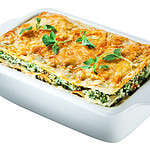
Feta and Spinach Lasagna Rolls
Ingredients
3 1/2 (16 ounce) boxes lasagna noodles (15–18 noodles in each box)
1 24-ounce container crumbled feta cheese (about 5 cups)
1 32-ounce container low-fat cottage cheese (4 cups)
1 32-ounce container part-skim ricotta cheese (3 1/2 cups)
1 cup shredded Asiago cheese (about 4 ounces)
I cup shredded Parmesan cheese
2 teaspoons black pepper
15 ounces frozen chopped spinach, broken apart and leaves separated
Supplies:
4 one-gallon freezer bags, labeled
On hand for each entrée:
2 cups marinara sauce
1 cup shredded mozzarella (about 4 ounces)
Instructions
1. Working in batches, boil noodles until flexible enough to roll but not completely cooked.
2. Meanwhile, mix feta, cottage cheese, ricotta, Asiago, Parmesan, and pepper in a large bowl. Stir in spinach leaves
3. Place partially cooked noodles on a clean work surface in a single layer (do not overlap).
4. Spread 3 tablespoons filling down the length of each noodle. Roll noodle and place seam side down on a rimmed baking sheet. Place rolls in freezer for 30 minutes.
5. Divide frozen rolls evenly among freezer bags. Seal and refreeze.
To serve:
1. Place 9 lasagna rolls in a 9×9 greased baking dish. Cover with foil; completely thaw in the refrigerator.
2. Preheat the oven to 350°F.
3. Pour 2 cups marinara over rolls and top with mozzarella; replace foil. Bake for 35 to 40 minutes, or until center is hot and cheese is melted.
Notes
Freeze for up to 4 months.
- Feta Cheese Fold-Overs
- Roasted Asparagus with Feta Cheese
- Stuffed Chicken Breasts with Feta, Spinach, and Ham
- Shrimp and Feta Scampi
Final Thoughts
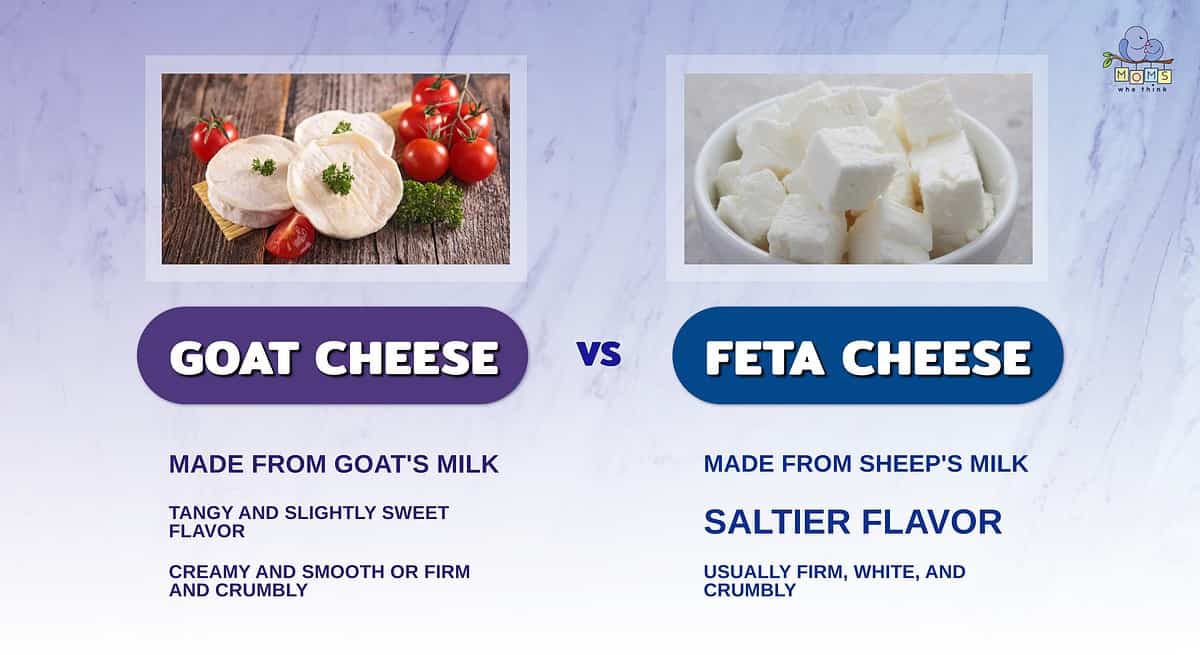
- Goat cheese, as the name might suggest, comes from goat's milk. Feta cheese, on the other hand, comes from sheep's milk.
- Feta cheese tends to have a saltier taste than goat cheese, which is known for its tangy and slightly sweet flavor. Which one you prefer depends on your own individual preferences.
- Both cheeses can vary in texture. Goat cheese can be creamy and smooth, or firm and crumbly. Feta cheese is typically firm, white, and crumbly, but certain varieties can be smooth and creamy.
In conclusion, while goat cheese and feta cheese may seem similar at first glance, they have distinct differences that make them unique. Goat cheese has a tangy flavor and creamy texture while feta cheese has a tangy and salty flavor and a crumbly texture. Both cheeses are versatile and useful in a variety of dishes, making them a great addition to almost any cuisine.
